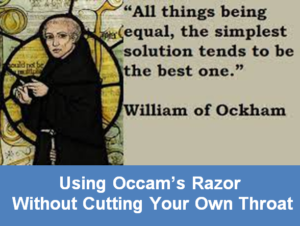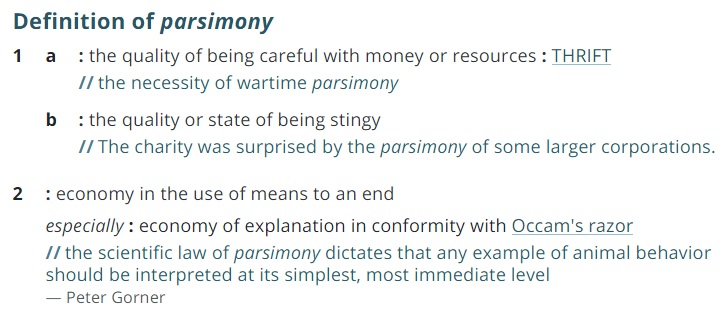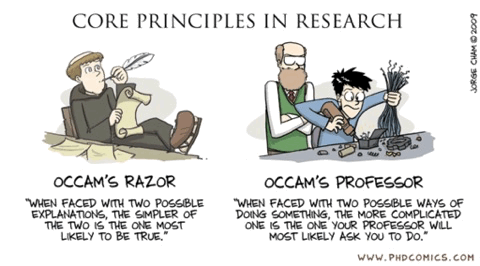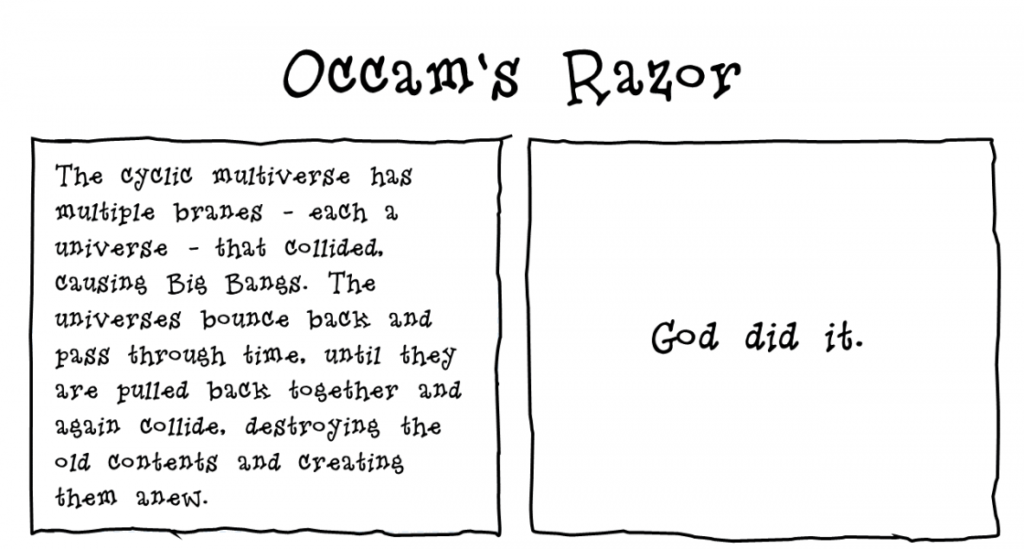 Occam’s razor is the law of parsimony. It’s a mental model of reasoning. At its core, Occam’s—also spelled Ockham’s or Ocham’s—states, “Among competing hypotheses, the one with the fewest assumptions should be selected.” Simpler yet, when solving a problem, the simplest solution is usually the right solution… but not too simple lest you cut your own throat.
Occam’s razor is the law of parsimony. It’s a mental model of reasoning. At its core, Occam’s—also spelled Ockham’s or Ocham’s—states, “Among competing hypotheses, the one with the fewest assumptions should be selected.” Simpler yet, when solving a problem, the simplest solution is usually the right solution… but not too simple lest you cut your own throat.
A razor is a philosophical principle, or heuristic (shortcut) rule of thumb, that allows you to cut to the chase of the matter and shave off, or eliminate, unlikely explanations for a phenomenon and/or avoid unnecessary actions. Razors include three reasoning forms: deductive, inductive, and abductive. We’ll get to those in a bit, but cutting to the chase of this piece, the simplest example of Occam’s razor is the duck test.
If it looks like a duck, walks like a duck, swims like a duck, has feathers, and quacks, then it’s probably a duck. There’s also the zebra test commonly used in medical fields to avoid unnecessarily complicated diagnosis—when hearing hoofbeats, think horses, not zebras.
That’s all fine and dandy when examining webbed birds and hooved mammals. How about using Occam’s razor in everyday situations like homicide investigations?
I was taught back in Murder School 101 to always use Occam’s razor for solving crimes. My mentor was an old sergeant named Fred Mahle. Wonderful guy, rest his soul. BTW, Fred was the RCMP detective who got child serial killer Clifford Olson to confess and turn over ten bodies for a fee of a hundred grand. Best business deal ever. Ten families got closure. Olson got life and painfully died in jail from pancreatic cancer.
Fred was right when he said, “Looking at murder cases, the simplest answer is usually the right answer, but be careful with that logic. It could backfire, and you could cut your own throat.” Fred also taught me that the more bizarre a situation, the closer the answer was to home. Additionally, Fred said, “You get more bees with honey than you do with vinegar” and, “You slide further on bullshit than you do on gravel”.
Anyway, back to Occam’s razor and how this logic works.
William of Occam was a fourteenth-century Franciscan friar who had trouble with conventional Christian doctrine like miracles. As a scholastic philosopher and theologian, William took a heuristic (mental shortcut) approach to explain the unexplainable. History credits William of Occam with wise quips like, “It is vain to do more with what can be done with fewer”, “A plurality is not to be posited without necessity”, “Circumstances being equal, that is better and more valuable which requires fewer”, and “Entities are not to be unnecessarily multiplied”.
Greats like Aristotle, Newton, Einstein, Hawking, and Sagan all bought into the law of parsimony—parsimony being defined as, “Quality of being careful with money or resources: Thrift. State of being stingy, economy in the use of a means to an end. Economy of explanation in conformity with Occam’s razor”. These thinkers knew the simplest explanation to a problem was preferable to one that’s more complex. (Usually).
Minds like these deferred to core mental models which are the way we see the world and interpret reality. Mental models include concepts like core competence, first principles thinking, thought experiment, second-order thinking, probabilistic thinking, inversion, and Occam’s razor. Great minds also employed the three forms of reasoning.
Deductive, inductive, and abductive reasoning support any analytical application of Occam’s razor. Rather than paraphrase what deductive, inductive, and abductive reasoning mean, I’ll simply copy and paste this piece from Merriam-Webster:
Deductive Reasoning
 Deduction is generally defined as “the deriving of a conclusion by reasoning.” Its specific meaning in logic is “inference in which the conclusion about particulars follows necessarily from general or universal premises.” Simply put, deduction—or the process of deducing—is the formation of a conclusion based on generally accepted statements or facts. It occurs when you are planning out trips, for instance. Say you have a 10 o’clock appointment with the dentist and you know that it takes 30 minutes to drive from your house to the dentist’s. From those two facts, you deduce that you will have to leave your house at 9:30, at the latest, to be at the dentist’s on time.
Deduction is generally defined as “the deriving of a conclusion by reasoning.” Its specific meaning in logic is “inference in which the conclusion about particulars follows necessarily from general or universal premises.” Simply put, deduction—or the process of deducing—is the formation of a conclusion based on generally accepted statements or facts. It occurs when you are planning out trips, for instance. Say you have a 10 o’clock appointment with the dentist and you know that it takes 30 minutes to drive from your house to the dentist’s. From those two facts, you deduce that you will have to leave your house at 9:30, at the latest, to be at the dentist’s on time.
Deductive reasoning always follows necessarily from general or universal premises. If a sandwich is defined as “two or more slices of bread or a split roll having a filling in between,” and a hot dog is defined as “a frankfurter; especially a frankfurter heated and served in a long split roll” then one must deduce that any hot dog served in a split roll is a sandwich.
Inductive Reasoning
Whereas in deduction the truth of the conclusion is guaranteed by the truth of the statements or facts considered (the hot dog is served in a split roll and a split roll with a filling in the middle is a sandwich), induction is a method of reasoning involving an element of probability. In logic, induction refers specifically to “inference of a generalized conclusion from particular instances.” In other words, it means forming a generalization based on what is known or observed.
For example, at lunch you observe 4 of your 6 coworkers ordering the same sandwich. From your observation, you then induce that the sandwich is probably good—and you decide to try it yourself. Induction is at play here since your reasoning is based on an observation of a small group, as opposed to universal premises.
Abductive Reasoning
The third method of reasoning, abduction, is defined as “a syllogism in which the major premise is evident but the minor premise and therefore the conclusion only probable.” Basically, it involves forming a conclusion from the information that is known. A familiar example of abduction is a detective’s identification of a criminal by piecing together evidence at a crime scene. In an everyday scenario, you may be puzzled by a half-eaten sandwich on the kitchen counter. Abduction will lead you to the best explanation. Your reasoning might be that your teenage son made the sandwich and then saw that he was late for work. In a rush, he put the sandwich on the counter and left.
If you have trouble differentiating deduction, induction, and abduction, thinking about their roots might help. All three words are based on Latin ducere, meaning “to lead.” The prefix de- means “from,” and deduction derives from generally accepted statements or facts. The prefix in- means “to” or “toward,” and induction leads you to a generalization. The prefix ab- means “away,” and you take away the best explanation in abduction.
Whether you reason by deduction, induction, or abduction, you can always learn from what the greats had to say about using Occam’s razor. Here are three reasonable quotes worth noting:
Albert Einstein referred to Occam’s razor when developing his theory of special relativity. He formulated his own version: “It can scarcely be denied that the supreme goal of all theory is to make the irreducible basic elements as simple and as few as possible without having to surrender the adequate representation of a single datum of experience. Or, everything should be made as simple as possible, but not simpler.”
Physicist Stephen Hawking advocated for Occam’s razor in his book, A Brief History of Time: “We could still imagine that there is a set of laws that determines events completely for some supernatural being, who could observe the present state of the universe without disturbing it. However, such models of the universe are not of much interest to us mortals. It seems better to employ the principle known as Occam’s razor and cut out all the features of the theory that cannot be observed.”
 Isaac Newton used Occam’s razor, too, when developing his theories. Newton stated: “We are to admit no more causes of natural things than such as are both true and sufficient to explain their appearances.” Newton sought to make his theories, including the three laws of motion, as simple as possible, with only the necessary minimum of underlying assumptions.
Isaac Newton used Occam’s razor, too, when developing his theories. Newton stated: “We are to admit no more causes of natural things than such as are both true and sufficient to explain their appearances.” Newton sought to make his theories, including the three laws of motion, as simple as possible, with only the necessary minimum of underlying assumptions.
Furthermore, simple is as simple does. A conclusion can’t rely just on its simplicity. It must be backed by empirical evidence. And when using Occam’s razor to make deductions, we must avoid falling prey to confirmation bias. In the case of the NASA moon landing conspiracy theory, for example, some people consider it simpler for the moon landing to have been faked, others for it to have been real.
Lisa Randall best expressed the issues with the narrow application of Occam’s razor in her book, Dark Matter and the Dinosaurs: The Astounding Interconnectedness of the Universe: “Another concern about Occam’s Razor is just a matter of fact. The world is more complicated than any of us would have been likely to conceive. Some particles and properties don’t seem necessary to any physical processes that matter—at least according to what we’ve deduced so far. Yet they exist. Sometimes the simplest model just isn’t the correct one. This is why it’s important to remember that opting for simpler explanations still requires work. They may be easier to falsify, but still require effort. And that the simpler explanation, although having a higher chance of being correct, is not always true.”
Occam’s razor is not intended to be a substitute for critical thinking. It is merely a tool to help make that thinking more efficient.
Harlan Coben has disputed many criticisms of Occam’s razor by stating that people fail to understand its exact purpose: “Most people oversimplify Occam’s razor to mean the simplest answer is usually correct. But the real meaning, what the Franciscan friar William of Ockham really wanted to emphasize, is that you shouldn’t complicate, that you shouldn’t “stack” a theory if a simpler explanation was at the ready. Pare it down. Prune the excess.”
Occam didn’t have the only razor in the think-tank shop. Other greats contributed to the critical thinking crowd. Here are some examples:
Hanlon’s razor — Never attribute to malice which can be adequately explained by stupidity.
Hitchen’s razor — What can be asserted without evidence can be dismissed without evidence.
Hume’s razor — What ought to be cannot be deduced from what is.
Alder’s razor — If something cannot be settled by experiment or observation, then it’s not worthy of debate.
Sagan’s razor — Extraordinary claims require extraordinary evidence.
Okay. This is all philosophical and eggheady. What about some real-life examples of critical thinking used to disprove flawed logic using Occam’s razor? To combat the Walmart of Weird Beliefs and the Grab Bag of Fake News? I’m not going to try and explain bizarre behavior like QAnon, Proud Boys, or crazy conspiracy theorists who wear tinfoil hats. As my wise, redneck brother-in-law Darryl says, “Ya can’t fix stupid.”
But I will touch on two high-profile puzzles that can be solved through the application of the law of parsimony—Occam’s razor. One is the JFK assassination. I’m a life-long student of that event and, at one time, I wasted hours debating the case on an internet board. Like Darryl says, “Ya can’t fix stupid”, so I gave up.
The Kennedy assassination brings out craziness in people. Conspiracy Theorists (CTs) will have you believe in a massive cover-up by the Illuminati, a hit by the Mafia, a plot by the military-industrial alliance, LBJ did it, and on and on and on and on…
Using Occam’s razor applied to the case facts, Lee Harvey Oswald acted alone. A deranged man brought his cheap rifle to work and shot the President of the United States—arguably the most powerful and important person in the world—from a tall building. Extraordinary claims require extraordinary evidence, right? After 57 years there hasn’t been one single irrefutable piece of evidence that anyone other than Oswald was involved. Nothing. The simplest answer here is the correct answer.
Another Occam’s application is explaining the enigma of Donald Trump. Trump supporters will have you believe the man is an impeccably-crafted genius with sight farther than the furthest horizon. Others, using Occam’s razor, simply say the man is a natural-born grifter and a common asshole. I know which explanation I’ll accept.
Remember, Occam’s razor is complemented by other mental models, including fundamental error distribution, especially Hanlon’s razor, confirmation bias, availability heuristic thinking, and hindsight bias. The nature of mental models is that they tend to all interlock in a lattice and work best in conjunction.
It is important to note, like any mental model, Occam’s razor is not foolproof. Like Fred said, use it with care, lest you cut your own throat. This is especially crucial when it comes to important or risky decisions. There are exceptions to any rule, and we should never blindly follow the results of applying a mental model which logic, experience, or empirical evidence contradict.
Using Occam’s razor, though, you’ll generally call out quackery with the duck test, and when you hear hoofbeats behind you, in most cases you should think horses, not zebras—unless you’re on the African savannah.







{Occam/Ockham/Ocham}’s Razor … interesting stuff indeed …
My simple mind wanders off to Richard Phillips Feinman’s wonderfully deep-thinking 3-word-philosophical-poem … I WONDER WHY …
ALSO – whenever ‘who shot JFK’ comes up … my simple mind swirls around on some of the many other conspiracy theories that abound.
My favourite came to me via a retired airline pilot who told me that the 9/11 attack at the Pentagon proved that the whole autrocity was orchestrated by the government of the ESofA and the evidence was that there were no “wing parts” found at that site … so the obvious conclusion – it was not an airplane but rather a US Cruise Missile – hahaha – in a word “bizarro” …
FEYNMAN … not Feinman …
Great post, Garry!
“Others, using Occam’s razor, simply say the man is a natural-born grifter and a common asshole.”
IMHO, the above can be applied to *several* former presidents, in addition to Congress. 🙂
Thanks, Deb! I rarely get political on this site but a good Trump-bash every now and then feels good. I have a pretty good idea which which politicians you might refer to but we’ll let ‘er slide for now. 🙂
Thanks, Garry. I’m familiar with Occam’s Razor but didn’t know about the other razors. Fascinating!
In the Olson case, did the killer receive the 100K? Does Canada allow criminals to profit of their crimes?
Yeah, the other stuff I dug up in this bunny-bin led me to some fascinating links. The site Farnam Street fsblog.com has some great info on mental models. I spend a half day on there and am going back for seconds.
Astonishingly, Canada has poor legislation governing criminals profiting from bad deeds. In the Olson case, the $100,000 was paid by the British Columbia Attorney General to Clifford Olson’s wife, Joan Olson. Cliff, himself, didn’t get a cent in his name. I met Joan Olson several times. She lived in Nanaimo and used to be Joan Cotton. Her brother, Ken Cotton, was a suspect in the Seattle area Green River murders (Gary Ridgeway) and I was the point person on the Vancouver Island Serious Crimes Section to liaise with the King County Sheriffs Office to investigate Ken Cotton – bad dude in his own right.
Excellent, Garry!
And I agree with you on the Olson deal and never understood the controversy – all other considerations aside, just continuing the investigation (to find the bodies) would have cost far in excess of $100,000. Look at what the Pickton case cost BC taxpayers ($102 Million).
I have to say that I disagree on JFK though, but as I was not even born then, I only know what I read (and even Oliver Stone called his movie speculation). That to me is still the one great conspiracy that has not yet been revealed. I think the “conspirators” set up such a plausibly simple explanation for just the reasons you explain in your very comprehensive blog here. I also think each incoming President is taken aside and warned: “remember what happened to Kennedy”, so that they don’t get out of line. As much of a disaster as Trump was, he still delivered the goods (financially) to the elite, like every other President, including Clinton.
Great outline of Occam and the different types of reasoning. Thank You.
Cheers!
The Olson cash-for-bodies agreement was one of the best returns on investment ever. I couldn’t understand why anyone had a moral, ethical, or legal issue with the deal. We’ll have to agree to disagree on JFK, though, Dan. I’ve done a huge dig into it and there’s nothing more to see here. I’m tired of it now and no longer debate it. Cheers back!!
I defer to your much more thorough knowledge and investigative experience regarding the JFK case, Garry. I also agree with Mike’s comment – the other Razors are terrific as well.
On Occam again, I find it interesting that in the current moment, the allegation that the Covid virus which originated in Wuhan, China actually came from the Wuhan lab – intentionally or not – is seen as the conspiracy theory when Occam would dictate that as the most likely explanation.
And that leads to the other great investigative question: Who gains? (Cui bono) “Follow The Money”.
I’m following this Wuhan conspiracy theory closely, Dan. This might be a true case here where the virus was cooked up in a lab and was accidentally released – not necessarily intentionally, but who knows about a place like China.
Since this Blog came around to me again by email with Bruce Coatta’s comment above (Oct 8th), I re-read it and, in a different frame of mind (and having just watched the conspiratorial movie Syriana again, too), I must say that I now agree with your assessment of the JFK assassination. Same with 9/11, as Bruce Coatta also mentions – complex situations have simple explanations.
I used to believe in a conspiracy in the JFK case, or I should say I wanted to believe in a conspiracy. In my teens and early 20s, I read a lot of JFK assassination books – most written by unqualified kooks – and I bought the BS. It wasn’t until the internet came along that I was able to read the Warren Report which was incredibly detailed. Same with Vincent Bugloisi’s book Reclaiming History. There is no way this thing happened other than Oswald acting alone. Thanks for your words, Dan.
Great post. I especially liked Hitchen’s and Hume’s contributions. Very handy in debate!
Thanks for stopping by, Mike. This was a fun time in the research rabbit hole. While rooting around, I came across a fascinating website called Farnam Street
https://fs.blog/ If you’re interested in mental models, this is well worth checking out.